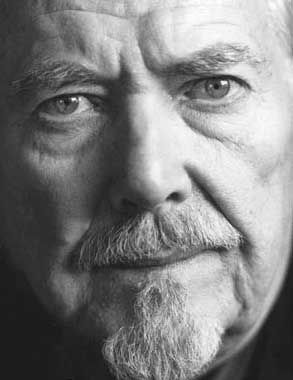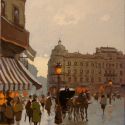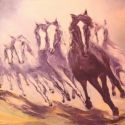 | During the 1970s, an era widely recognized as a renaissance period of American moviemaking, few directors enjoyed greater prominence than Robert Altman. An iconoclast whose work acutely attacked the conventions of genre filmmaking, Altman both satirized and revitalized such warhorses as the western, the musical, and the crime drama, waging war on the sterile artifice of mainstream storytelling by creating a singularly sprawling and deliberately messy cinematic world bursting at the seams with sounds, images, characters and plot lines. |
Famed for his inventive brand of overlapping (and often improvisational) dialogue and an acknowledged master of modern camera technique, Altman's quixotic career has been uneven at best, yet he remains a pivotal figure of contemporary cinema, a true maverick responsible for many of the defining motion pictures of his times.
Born February 20, 1925, in Kansas City, MO, Altman was educated in Jesuit schools prior to joining the Army at the age of 18; over the course of WWII, he flew over 50 bombing missions in Borneo and the Dutch East Indies. Upon his discharge in 1947, Altman studied engineering at the University of Missouri, later inventing a tattooing machine designed for the identification of dogs. He entered filmmaking only as a whim, selling to RKO the script for the 1948 picture The Bodyguard, which he co-wrote with Richard Fleischer. Altman's immediate success encouraged him to move to New York City, where he attempted to forge a career as a writer; he enjoyed little luck, however, and after a similarly fruitless trip to the West Coast, he returned to Kansas City, accepting a job as a director, writer, cameraman and editor of industrial films for the Calvin Company.
After helming some 65 industrial films and documentaries, by 1955 Altman had secured over $60,000 dollars in financing from local backers to make his own feature; two years later, the finished product, titled The Delinquents, was purchased by United Artists for 150,000, dollars and while primitive, it contained the foundations of his later work in its use of casual, naturalistic dialogue. He next co-produced 1957's The James Dean Story, a documentary rushed into theaters to capitalize on the actor's recent death and marketed to the cult following emerging in the wake of the tragedy; while a box-office disappointment, it brought Altman to the attention of Alfred Hitchcock, who tapped him as a director for his CBS television anthology series Alfred Hitchcock Presents. After just two episodes, 1957's "The Young One" and the next year's "Together," Altman was fired, but the exposure enabled him to mount a successful TV career in series including Bonanza, Combat, and The Kraft Suspense Theater.
Television allowed Altman the chance to experiment with narrative technique as well as develop his trademark overlapping dialogue, all the while learning to work with speed and efficiency on a limited budget. Though frequently fired for his refusal to conform to network mandates as well as his insistence upon injecting his material with political subtexts and antiwar sentiments, Altman never lacked assignments in an industry desperate for experienced talent; he even formed his own production company, Lions Gate Films, although his gambling debts nearly brought about its demise. In 1964, one of his episodes for The Kraft Suspense Theater was expanded for commercial release under the name Nightmare in Chicago; two years later, he accepted an invitation to direct the low-budget space travel feature Countdown, but was fired within days of the project's conclusion because of his refusal to edit the film down to a manageable length.
Altman did not direct another movie until 1969's That Cold Day in the Park, a critical and box-office disaster. For his next project, he agreed to adapt a little-known Korean War-era novel satirizing life in the armed services; the film had already been passed over by over a dozen other filmmakers, and production was so tumultuous that stars Elliott Gould and Donald Sutherland even attempted to have Altman fired over his unorthodox filming methods. Upon its 1970 release, however, M.A.S.H. was widely hailed as an immediate classic, winning the Palm d'Or at the Cannes Film Festival and netting six Academy Award nominations. Now recognized as a major talent, Altman fielded countless offers to direct big-budget studio films, but instead opted to develop the surreal and experimental Brewster McCloud under his own Lions Gate imprint; issued in 1970, the ambitious but flawed film was the victim of poor box-office returns and mixed criticism, although the director himself claimed it to be his favorite among his features.
With the 1971 revisionist Western McCabe and Mrs. Miller, however, Altman returned to form in stunning fashion. Still, regardless of widespread media acclaim (in particular for Vilmos Zsigmond's beautifully hazy cinematography), it met with commercial indifference, and despite the success enjoyed by M.A.S.H., historically Altman never earned mainstream recognition remotely comparable to his critical stature. Indeed, only the likes of Martin Scorsese, Francis Ford Coppola, and Woody Allen managed to produce work of a similar caliber to Altman during the early '70s, from the atmospheric, idiosyncratic Raymond Chandler adaptation The Long Goodbye to the Depression-era romantic caper Thieves Like Us to the gambling study California Split. In film after brilliant film, he created one of the most provocative and original bodies of work in contemporary American cinema, yet audiences stayed away in droves; perhaps most emblematic of Altman's box-office woes was California Split, which was already running on television only two years after its theatrical release.
With his 1975 masterpiece Nashville, however, Altman reentered the American cultural consciousness; his finest film to date, it was hailed from many corners as one of the decade's greatest works, earning five Oscar nominations. A sprawling, intricate meditation on show business and politics featuring some two dozen major characters, Nashville not only restored the director's box-office lustre, but it also brought his newly-developed Lion's Gate eight-track sound system to its full realization, allowing Altman to record sound live on the set with microphones instead of more cumbersome equipment, eliminating post-dubbing and making possible later mixing and unmixing to achieve a dense, multi-layered soundtrack. Released during the nation's July 1976 bicentennial celebration, Altman next unveiled Buffalo Bill and the Indians, or Sitting Bull's History Lesson, starring Paul Newman. As widely savaged as Nashville was widely acclaimed, it was subsequently re-edited for German consumption by producer Dino de Laurentiis, and upon winning the Grand Prix at the Berlin Film Festival, Altman refused the honor on the grounds that the de Laurentiis cut misrepresented his vision.
The public feud with de Laurentiis ended Altman's hopes of directing the feature adaptation of E.L. Doctorow's novel Ragtime, and also put the skids on a long-planned filmization of Kurt Vonnegut's Breakfast of Champions. Instead, Altman turned to 1977's 3 Women, a dreamlike, Bergman-esque drama, followed a year later by A Wedding, a complex black comedy with close to 50 major roles. Yet again, audiences failed to relate to the material, and after 1979's futuristic Quintet opened and closed after just one week, both the romantic comedy A Perfect Couple and the satiric Health ran into insurmountable distribution problems and barely even surfaced in theaters.
Altman next mounted Popeye, a musical based on the classic E.C. Segar comic strip with comedian Robin Williams in the title role and a script by Jules Feiffer; when the highly-anticipated production failed to live up to commercial or critical expectations, he responded by selling Lions Gate, effectively bringing to an end his career as a mainstream Hollywood filmmaker for over a decade.
Altman then turned to the stage, forming Sandcastle 5 Productions and agreeing to direct Ed Graczyk's Come Back to the Five and Dime, Jimmy Dean, Jimmy Dean on Broadway; in 1982, he also helmed a feature version for the cable network Showtime. David Rabe's Vietnam War drama Streamers followed a year later, and like its predecessor rejected the freewheeling flair of the director's 1970s work in favor of a more restrained and measured style closer in spirit to the theater; still, Altman remained as idiosyncratic as ever, directing 1984's Richard Nixon docudrama Secret Honor in a campus dormitory with the aid of student assistants while serving as a visiting professor at the University of Michigan. An adaptation of Marsha Norman's The Laundromat, commissioned by Home Box Office, followed in 1985, with a rendering of Sam Shepard's Fool for Love appearing a year later. Altman then enjoyed a remarkably prolific 1987 with two feature films, Beyond Therapy and O.C. and Stiggs, as well as two hour-long presentations for ABC television, The Dumbwaiter and Room.
Altman's return to television after an absence of over two decades continued in 1988 with The Caine Mutiny Court Martial and the HBO miniseries Tanner '88, a scathing and well-received satire of the year's Presidential election penned with Doonesbury creator Garry Trudeau. The 1990 Van Gogh portrait Vincent and Theo earned similarly strong notices, prompting many to wonder if Altman was about to make a comeback; 1992's The Player, a brutal attack on Hollywood morality brimming with major stars, answered their questions -- Altman was indeed back, with strong box-office receipts and three Oscar nominations to prove it. Suddenly finding himself again on the A-list, he mounted 1993's Short Cuts, adapted from short stories by Raymond Carver --- a brilliantly provocative look at contemporary Los Angeles society similar in execution and tone to Nashville and the recipient of almost as much acclaim. However, both 1994's Ready to Wear (Pret-A-Porter) and 1996's Kansas City were dismally received, and with 1998's John Grisham adaptation The Gingerbread Man, Altman found himself at the center of controversy when producers re-cut the picture following a disastrous preview screening. It finally appeared in its intended form to decidedly mixed reviews and lackluster box office. However, Altman enjoyed greater success a year later with Cookie's Fortune. An ensemble piece about the denizens of a small Mississippi town, the film received a generally amicable reception.
Altman's next project, Dr. T and the Women (2000), a fanciful comedy about a Dallas gynecologist (Richard Gere) who becomes overwhelmed by the women in his life, marked Altman's second collaboration with screenwriter Anne Rapp after Cookie's Fortune. It also earned mixed but generally positive reviews, many concluding that despite his previous missteps, the director had still not lost his distinctive touch. This may have been evidenced moreso than any other time in recent memory when the feisty Altman recieved the Best Director award at the 59th Annual Golden Globes for his comedic period murder-mystery, Gosford Park (2002).
Recalling Alan Bridges's 1984 film The Shooting Party, the film enlisted a five-star cast including Maggie Smith, Michael Gambon, Kristin Scott-Thomas and Emily Watson; it subsequently culled a myriad of Oscar nominations including nods for Best Picture, Best Director, and Best Screenplay (by James and Julian Fellowes), losing the first two but winning the latter.
December 2003's The Company dramatizes one year in the life of the Joffrey Ballet and stars Neve Campbell (who doubled as screenwriter); critics and the public responded enthusiastically, even if the picture maintained a lower profile than Gosford.
Meanwhile, the octogenarian Altman - a longtime fan of thirty-year-plus radio humorist Garrison Keillor - devised the idea for a fluid filmization of Keillor's Minnesota-based radio program, A Prairie Home Companion, and phoned Keillor one day, asking him to write the script. Several months later, with no word from Keillor, Altman phoned him again only to discover that the radio host hadn't taken him seriously the first time out! A second bid yielded a firmer commitment from Keillor, who then wrote the script, and mailed it to Altman. Thrilled with Keillor's draft, the director stepped behind the camera once again in 2005, and made full use of a once-in-a-lifetime cast that included Altman standby Lily Tomlin, Meryl Streep, Lindsay Lohan, Kevin Kline, John C. Reilly, Woody Harrelson, and, most surprisingly, Keillor himself. It opened in early summer, 2006 to rave reviews, critic after critic praising its warm geniality and folksy charm.

































